imrightwereyouleftme
3K posts
queer Taylor Swift fan dni hetlors, terfs, radfems, bigots etc. echo's main
Don't wanna be here? Send us removal request.
Text
Sometimes I remember the high of being convinced that taylor swift was secretly nils sjoberg on This Is What You Came For, apropos of quite literally nothing other than recognizing her voice in back up vocals during a few moments in the song where she sang no words, just ooooo for two seconds at a time, then finding out that you were RIGHT about that.... absolutely bonkers. and i'm like yeah no wonder swifties are nuts. they've been chasing that high ever since.
491 notes
·
View notes
Text
People declaring they’ve gotten over their Taylor Swift obsession and dramatically taking down their posters of her and stuff on TikTok because they “haven’t really been listening lately” is always so hilarious to me. When I don’t listen to Taylor for a while, I’ll have shuffle on one day and a Taylor Swift song will come on, and then I’ll genuinely have to pause whatever I’m doing to sit there with the song thinking holy shit WHAT a tune! Do you think she realizes what a banger she had on her hands here? And then I go back to living my life with Taylor Swift still in my heart. It has been like this since I was ten years old. We are not the same!
3K notes
·
View notes
Text
"why do you hate travis so much?" because i can. free urself from swiftieism's chains and u can do it too
37 notes
·
View notes
Text
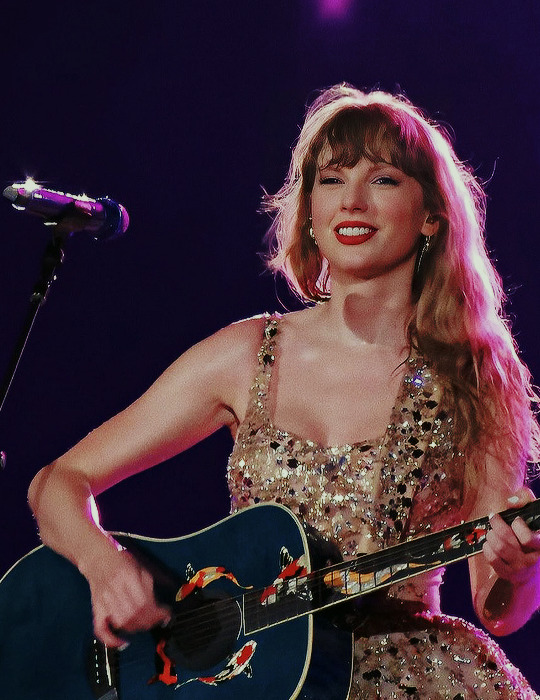
my favorites pics of 'the eras tour' ♡
1K notes
·
View notes
Text
it’s just like. maybe she just liked the colors of the bi flag and dyed her hair for fun. maybe she liked the idea of cedar closets and was inspired to write a song about an ex boyfriend. maybe she wore a rainbow dress during her pride speech because rainbows are pretty. maybe she dressed like a pride flag flamingo for wango tango to match pride month as an ally. maybe she said that gay pride makes her her because she’s that committed to allyship. maybe she heard about the connotations of lavender in the 50s and wrote a song about how that mirrors her feelings for her boyfriend. maybe she’s never heard of the “hair pin drop around the world” (stonewall) and just chose something that wouldn’t make much noise. maybe she really just likes singing from alternate perspectives. maybe she forgot to change the pronouns when she covered riptide from a female perspective. maybe she put herself in glass closets in multiple music videos because she feels trapped by herself. maybe she wrote so much about secrecy on reputation because she thought if she was seen with her boyfriend publicly it would ruin the relationship. maybe she wrote so much about secrecy in her earlier albums because she prefers privacy. maybe she wrote about secrecy on folklore and evermore because she was writing fiction. maybe she compared loving her partner to sin that forfeits her good standing with god and the world because she likes to be dramatic. maybe the very first night is about a guy and she just accidentally made the verses rhyme with “her”. maybe she really likes daisies because they’re pretty. maybe connections between cruel summer and closure are accidental. maybe connections between it’s time to go and down bad are accidental. maybe she’s been best friends with all of her lovers. maybe!
………………However,
129 notes
·
View notes
Text
The Glass Closet: Taylor Swift, Chely Wright, Speculation, and the Industry That Keeps Artists in the Dark
For nearly two decades, Taylor Swift has orchestrated the art of reinvention—from a fresh-faced country prodigy to a global pop powerhouse, from America’s golden girl to a self-proclaimed anti-hero. Each era has been a transformation, each reinvention a shield. Yet, beneath the carefully curated personas, the shifting aesthetics, and the highly publicized relationships, one unspoken question lingers: Who is Taylor Swift, really?
The theory that Swift is queer and closeted—the heart of the “Gaylor” conversation—isn’t about unfounded gossip. It’s about the systems that shape an artist’s image, the forces that dictate what is and isn’t acceptable, and the very real cost of authenticity in an industry that thrives on marketability over truth.
To understand this, we have to look beyond Swift herself. We have to examine country music’s history of closeting artists like the fallout that followed Chely Wright’s coming out and the impossible balancing act Swift has performed for years.
This is a story about control, coded storytelling, and the glass closet Taylor Swift has spent her career trying to break free from—without ever shattering it completely. It's a story of paving the path for a brighter, louder, more colorful future because one thing is for sure...
SHADE NEVER MADE ANYBODY LESS GAY!

The Early Aughts + Country Music Stardom: A Foundation Built on Silence
Country music has long been one of the most traditionally conservative genres in the music industry. With a core audience rooted in Middle America values, the genre has historically upheld white, heterosexual, Christian narratives as the foundation of its storytelling.
Even in 2025, there are only a handful of openly queer country artists, and most of them struggle to receive mainstream recognition. Artists like Brandi Carlile, T.J. Osborne (Brothers Osborne), and Brandy Clark have helped pave the way, but country radio still hesitates to fully embrace LGBTQIA+ voices.
In this world, being an openly queer artist isn’t just risky—it’s career-ending.
And no one embodies that reality more than Chely Wright.
Chely Wright: A Warning from the Closet
In 2010, Chely Wright became the first mainstream country artist to come out as lesbian and it destroyed her career.

Wright was a hitmaker, with #1 songs and major industry recognition. She had everything an artist could want—until she told the truth.
Country radio blacklisted her.
Venues stopped booking her.
Her album sales tanked.
The industry that once celebrated her pretended she never existed.
Her story became a cautionary tale—a stark warning that country music does not embrace queer artists. It erases them.
By 2010, Taylor Swift was already a superstar. If she was questioning her sexuality—or even fully aware of it—she had already been placed in a carefully controlled box.
Unlike Wright, Swift’s departure from country music wasn’t an exile—it was an escape. But that escape wasn’t just about genre. It was about control. It was about building a world where she could reinvent herself while keeping parts of her identity just out of reach.
youtube
A Different Perspective: Chely Wright’s Discomfort with Speculation
When The New York Times published an essay on the Gaylor theory, I was surprised to find that Chely Wright herself expressed discomfort with the way Taylor Swift’s sexuality is discussed in public. Wright called the piece “awful” and “triggering”, criticizing the newspaper for engaging in speculation. Given that Chely’s story has long been a major point of discussion in the Gaylor community, her response was jarring. At first, it made me question whether using her experience as a lens for understanding Taylor’s career was appropriate.
But upon deeper reflection, her reaction makes sense. Chely Wright’s coming-out experience was deeply traumatic—she spent years hiding, lying, and carefully constructing a false image to survive in country music. And when she finally told the truth, her career collapsed overnight. For Wright, the mere act of publicly discussing another artist’s sexuality—whether as support or analysis—might feel like the same kind of external pressure she once faced.
However, there is an important distinction: The Gaylor conversation is not about forcing a label onto Taylor Swift. It’s about analyzing the subtext Swift has deliberately embedded in her work. If Taylor wasn’t queercoding her music, this conversation wouldn’t exist in the first place.
It’s also crucial to recognize that the industry forces that once silenced Wright are the same forces that shaped Swift’s career. While Wright may reject this discussion entirely, that doesn’t change the reality that Taylor’s work is filled with coded storytelling—suggesting she is navigating the same strict boundaries but in a different way.
Wright’s response to the op-ed highlights a larger cultural question: Why does queerness still have to be treated as a secret, while speculation about straight relationships is encouraged?
Why Is Speculating About Queerness Seen as Different?
One of the biggest criticisms of the Gaylor theory is that it’s “invasive” to speculate about Taylor Swift’s sexuality. But where is the line between analyzing queer themes in her work and being inappropriate? Why do Swifties who push back against this theory have no problem speculating about her relationships with men?
This is where the double standard comes into play.
Taylor Swift fans have spent years digging into her personal life—analyzing lyrics, finding Easter eggs, and debating which songs are about which boyfriend. Entire media cycles have been built on this:
Is "All Too Well" about Jake Gyllenhaal?
Is she secretly engaged? Was she secretly married?
Was "You Belong With Me" about Joe Jonas?
These questions are not only accepted— they're expected.
But when Gaylors apply the same level of analysis through a queer lens, suddenly, it’s labeled “invasive” and “harmful.” The message is clear: It’s only okay to speculate if the answer is straight.
To me, this is an outdated view to force straightness onto someone while also claiming that sexuality is a spectrum. Given Taylor’s layered storytelling, it feels necessary to allow her to exist on that spectrum—where maybe some of her stories are not what they seem.
As we know, Taylor Swift spent the early years of her career operating under the rigid gender norms of country music, a world where women were expected to sing about heterosexual romance, faith, family, and small-town nostalgia. But as her success grew, so did her desire for creative control—and possibly, her need to carve out a space where she could express herself more authentically, even if only in coded ways.
Her transition to pop wasn’t just about breaking genre boundaries—it was about escaping Nashville’s conservative grip and stepping into a world where reinvention, subtext, and ambiguity could thrive. And she made that clear from the very first song on 1989.

“Welcome to New York”: Taylor’s Break from Nashville & Living In Screaming Color
"You can want who you want / Boys and boys and girls and girls."
This wasn’t just a throwaway lyric. It was the loudest queer-coded statement she had ever made—and it opened the album that marked her escape from country music’s restrictions.
This is also the era that she gave us New Romantics and Out of the Woods with lyrics like, "The rest of the world was black and white but we were in screaming color."
Many Gaylors believe that Red (2012) was already a queer-coded album, with songs about a secret relationship—possibly with Dianna Agron—hidden behind PR relationships with men. But in 2014, she took it a step further:
She stopped centering men in her music.
She built a “girl squad” narrative that celebrated female friendships—but felt, at times, like something more.
She became more private—hiding her personal life while crafting an ultra-public, ultra-marketable persona.
If Red was about testing boundaries, 1989 was about reinvention as a shield. From this moment forward, Taylor would never again present her personal life without layers of control.
Reinvention as Survival: The Dual Taylors
Swift has reinvented herself with every era, but this reinvention isn’t just about artistic evolution—it’s been a survival mechanism.
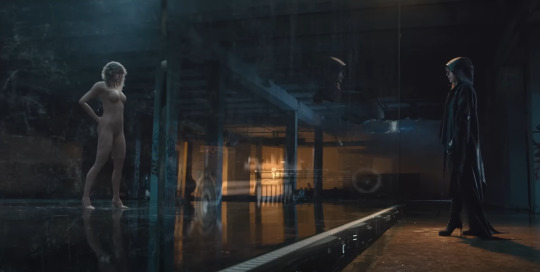
She constantly presents two versions of herself—the one the public sees, and the one hidden beneath the surface.
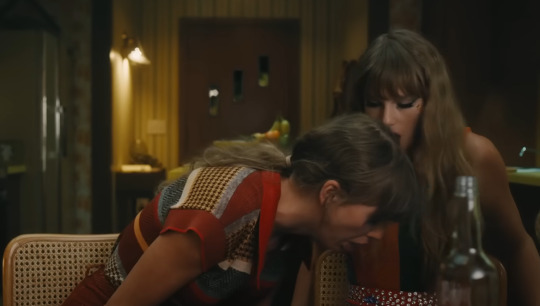
This is the essence of the glass closet—where an artist can leave clues, drop hints, and tell the truth without ever being forced to say it outright.
Why Taylor Swift’s Closet Is Different
Unlike Chely Wright, Swift never had to lose her career over her sexuality—but that’s because she never let it become the story in the first place. The longer she hints, codes, and subtextually confesses, the veil gets thinner.
When she says “ME! out now” on Lesbian Visibility Day, people still think it’s a coincidence. When she plays "Maroon" on Karlie's birthday, it doesn't mean anything. Somehow, even when a song with such an obvious rhyme scheme as "The Very First Night" all but hits you over the head alluding to a female pronoun in a love song, Swifties turn the other cheek and deny the obvious.
She has spent 20 years writing about love—but to the general public, that love has only been for men. For those who see through the lines, she has been communicating her real experience the entire time.
Swift’s public relationships always seem to appear when speculation about her queerness reaches a peak. The Summer of Lover 2019? Joe Alwyn’s presence is reinforced. The Midnights era? Enter Matty Healy, a quick PR cycle that fizzled just as fast as it began. And now, in 2024, with The Tortured Poets Department drenched in queer themes? Travis Kelce is front and center. Whether these relationships are real, exaggerated, or entirely contractual, they always serve a purpose—to keep the glass closet from completely shattering.
The Power of Subtext in the Mainstream
In many ways, Taylor has done something radical—she’s embedded queerness into mainstream pop culture in a way that allows it to exist without being outright rejected.
Before her, queerness in the industry was often either completely hidden or presented in a hypersexualized, rebellious way that still played into the male gaze (see: Madonna and Britney’s VMAs kiss, Katy Perry’s “I Kissed a Girl”).
Taylor’s approach is different. Her queerness isn’t a spectacle—it’s woven into love songs, metaphors, and heartbreak anthems, allowing it to be as deeply felt and widely consumed as straight narratives.
For younger artists, this has cracked open the door.
Queer Artists Who Have Benefited from the Shift
Artists who emerged in the post-Taylor pop landscape now have far more room to exist as their authentic selves. Many don’t have to code their queerness the way Taylor does, and that’s partially because her queer-coding forced the industry to acknowledge that queer narratives could be commercially successful.
Examples of artists who have benefited from this shift include:
Kelsea Ballerini – A country-pop artist and close friend of Taylor Swift, Kelsea has been a vocal LGBTQIA+ ally, advocating for inclusivity in a traditionally conservative genre. While not publicly queer, her embrace of queer narratives and shift toward pop mirrors Swift’s own path, signaling a slow but growing evolution in country music.

Girl in Red – Explicitly queer in both image and lyricism, yet embraced by the same industry that would have never allowed Taylor to be this open in 2006.

MUNA – An openly queer pop band that has been able to build mainstream success without needing to obscure their identities.

Billie Eilish – After coming out as queer in 2023, Billie has embraced her identity without industry pushback, reflecting the shifting landscape Taylor helped shape. Her openness marks a new era where pop stars no longer need to rely on subtext or plausible deniability to exist authentically.
youtube
Chappell Roan – The most recent example of a queer artist who is making waves in the pop scene—heavily inspired by the theatrical elements of Taylor Swift’s songwriting and world-building.

Would any of these artists have been able to flourish in the mainstream ten years ago? Unlikely. Taylor’s massive, industry-defining career—and the queer interpretations of her work that have never been shut down entirely—helped normalize the idea that queerness doesn’t have to be a commercial risk.
The Unfinished Revolution: Taylor’s Influence on the Future of Queer Storytelling
Taylor Swift’s position in pop culture is unique—she is arguably the most famous person in the world, yet her true identity remains one of the most debated subjects in modern music.
This paradox—existing in a glass closet while simultaneously paving the way for others to live openly—is what makes her influence so undeniable.
Taylor Swift may never fully break out of the closet herself—but she has already blown the door open for others to walk through.
She has spent two decades bending the rules of the industry, proving that queer-coded storytelling is not just marketable but deeply resonant. The next generation of artists doesn’t have to bend the way she did—they can step into the spotlight and tell their stories without hiding behind mirrors and metaphors.
Taylor may be trapped in the glass closet, but the industry she reshaped will never be able to shut the door again.
LONG LIVE THE WALLS WE CRASHED THROUGH!
196 notes
·
View notes
Text


all's well that ends well to end up with you
674 notes
·
View notes
Text
I was just reminded that not only was the Bejeweled MV "she ghosted" to the Super Bowl exactly 838 days apart
But THE HAIM SISTERS WERE WITH TAYLOR. You know, the same Haim Sisters that were in the Bejeweled MV.
I don't know if this means that this marks it truly being over but oh my god did she make it clear that this is exactly the date that "she ghosted" was pointing to.


And reiterating once again that Bejeweled MV was recorded on 8/3, then released 83 days later on a random Tuesday. We were all confused at the timing, but it was literally so that she could drop it 83 days apart.
For the MV she made sure to express had so many Easter eggs attached to it that she needed a pdf file.
If you're still denying Late Stage Kaylor... I don't know what to tell you. There's only so many times it can be 8/3 before it is absolutely intentional
212 notes
·
View notes
Text
for the non-Americans who are very confused right now:
Everyone hates The Chiefs this year because it's quarterback Patrick Mahomes is low-key MAGA and the orange pestilence is in attendance in the game. And the racist ass "chop" their fans do. and that Traves Kelce said it would be "an honor" to host the orange pestilence at the game.
and now they're fucking losing and Taylor is going to DUMP him and join Kendrick in writing an absolutely devastating breakup anthem.
38K notes
·
View notes
Text
and when i say that men booing taylor and erupting in cheers for trump is rooted in misogyny
958 notes
·
View notes
Text
trump just shared a video of taylor being booed at the super bowl and it’s captioned with “the world is healing”… taylor should be allowed to kill at least one man per week, starting with him
4K notes
·
View notes
Text

TN taking down the hetero T / male ownership allegations
126 notes
·
View notes
Text



Taylor Swift at the 67th Annual Grammy Awards on February 02, 2025 in Los Angeles, California (📷: John Shearer/Getty Images)
506 notes
·
View notes
Text
The large number of songs Taylor Swift has made that are about forbidden love is very telling, if you ask me. Not to mention how she’s constantly referencing Christianity, and churches, and old-fashioned beliefs, and sin, and religion in general. Like, are y’all really not hearing her?
And there’s a huge amount of Taylor Swift songs where she uses the pronoun “you” for the muse, not describing them as a man nor a woman, whilst also mentioning one or more of her past love interests, describing them as “Kens” and “playthings for her to use”, talking about how she’s been toying them around and how they never satisfied her in the same way her current muse does… the boys and their expensive cars have never taken her quite where her current muse does. And isn’t it funny how the muse in question is almost never explicitly stated to be a man in songs like this?
I just find it strange how so many people seem to completely miss this. Taylor Swift haters often use the argument “All her songs are about her exes” when hating on her, but if you ask me, “All her songs are about forbidden love, religious guilt to some degree and how society will never accept her and her love” is much more accurate.
347 notes
·
View notes
Text
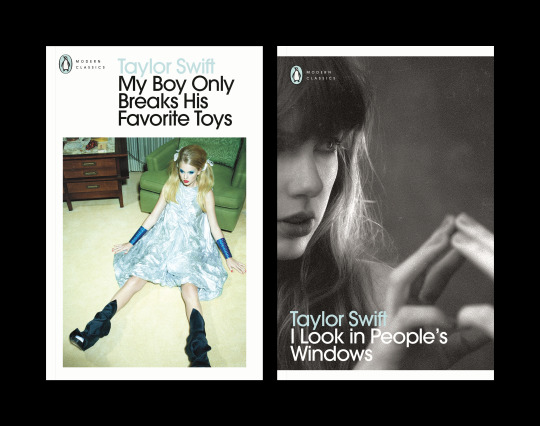
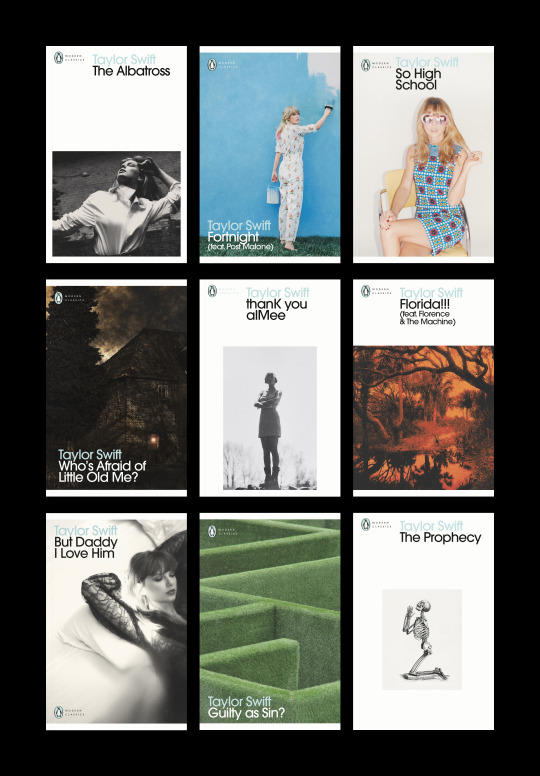
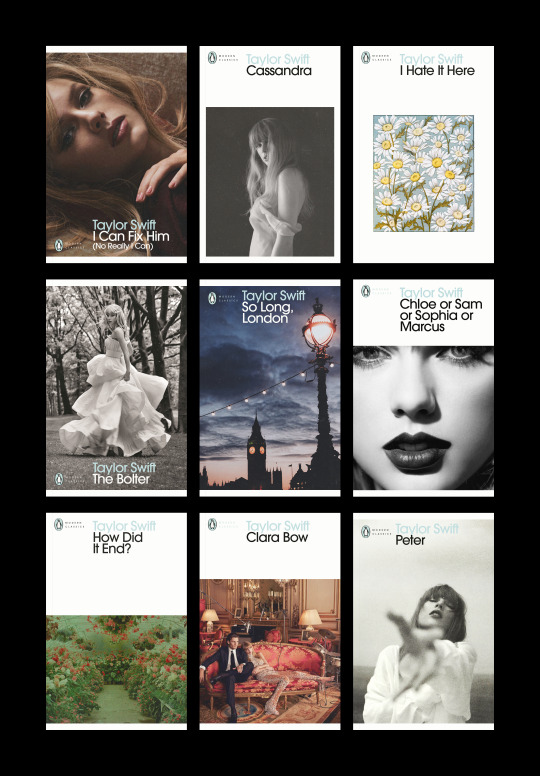
Songs from The Tortured Poets Department as Penguin Modern Classics ✨
2K notes
·
View notes













